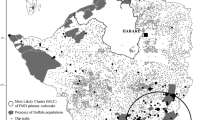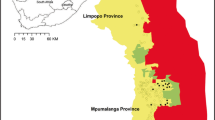Abstract
Diseases affecting livestock can have significant impacts on the animal, humans and the economy. Participatory epidemiology and spatial analysis were conducted to assess livestock disease problems in Samburu County, northern Kenya. Key informants were selected purposively with the help of local leaders. Among the livestock, goats were identified to have the most economic importance. On the other hand Pestes des Petits Ruminants (PPR), Foot and Mouth Disease (FMD) and Camel Trypanosomiasis diseases were identified to have the highest impact on pastoral livelihood. Spatial analysis indicated that all the disease hotspots were closely related to the distribution of herds during different seasons of the year. Correlations between the mean annual rainfall and selected livestock diseases were significant for East Coast Fever (ECF) (r = − 0.767, p = 0.001, N = 15), Cattle Helminthiasis (r = 0.639, p = 0.010, N = 15), Cattle Anaplasmosis (r = 0.631, p = 0.012, N = 15) and Camel Pox (r = − 0.646, p = 0.044, N = 10). There was a strong relationship between seasonality and livestock disease epidemiology. Disease control efforts should be focused towards the hotspots in the wet season and dry season grazing areas.





















Similar content being viewed by others
Data availability
The datasets generated during and/or analyzed during the current study and used in the production of this article are available from the corresponding author and can be availed upon reasonable request.
References
Akoyo, J.A. and Songok, N. 2013. County Livestock Development Plan For Turkana, West Pokot, Samburu And Baringo 2013–2017.
Alders, R.G., Ali, S.N., Ameri, A.A., Bagnol, B., Cooper, T.L., Gozali, A., Hidayat, M.M., Rukambile, E., Wong, J.T. and Catley, A. 2020. Participatory Epidemiology: Principles, Practice, Utility, and Lessons Learnt. Front. Veterinary Science 7, 532763. https://doi.org/10.3389/fvets.2020.532763.
Barasona, J. A., Latham, M. C., Acevedo, P., Armenteros, J. A., Latham, A. D. M., Gortazar, C., ... & Vicente, J. 2014. Spatiotemporal interactions between wild boar and cattle: implications for cross-species disease transmission. Veterinary research, 45(1), 1–11.
Bayissa, B., Bereda, A., Consults, A. 2009. Assessment of Veterinary Service Delivery, Livestock Disease Reporting, Surveillance Systems and Prevention and Control Measures across Ethiopia/Kenya Border Enhanced Livelihoods in Southern Ethiopia (ELSE) Project. CIFA Ethiopia/CARE Ethiopia.
Bett B, Jost C and Mariner J. 2008. Participatory investigation of important animal health problems amongst the Turkana pastoralists: Relative incidence, impact on livelihoods and suggested interventions. Discussion Paper No. 15. Targeting and Innovation. ILRI (International Livestock Research Institute), Nairobi, Kenya. 50 pp.
Bizimana, N. 1994. Epidemiology, surveillance and control of the principal infectious animal diseases in Africa. Rev. sci. tech. Off. int. Epiz., 13 (2), 397-416.
Bouslikhane, M. 2015. Cross border movements of animals and animal products and their relevance to the epidemiology of animal diseases in Africa. OIE Africa Regional Commission.
Caron, A., Miguel, E., Gomo, C., Makaya, P., Pfukenyi, D. M., Foggin, C., ... & de Garine-Wichatitsky, M. 2013. Relationship between burden of infection in ungulate populations and wildlife/livestock interfaces. Epidemiology & Infection, 141(7), 1522–1535.
Catley, A. and Admassu, B. 2003. Using Participatory Epidemiology to Assess the Impact of Livestock Diseases. FAO-OIE-AU/IBAR-IAEA Consultative Group Meeting on Contagious Bovine Pleuropneumonia in Africa 12-14 November 2003, FAO Headquarters, Rome, Italy.
Catley, A. and Mariner, J. 2002. Where there is no data: Participatory approaches to veterinary epidemiology in pastoral areas of the Horn of Africa. International Institute for Environment and Development (iied). Issue paper no. 110.
Catley, A. 2005. Participatory Epidemiology: A Guide for Trainers. African Union/Interafrican Bureau for Animal Resources, Nairobi.
County Director of Veterinary Services (2015). Participatory Disease Surveillance in Samburu County, Kenya: Field Report.
FAO and OIE. 2004. Global Framework for the Progressive Control of Transboundary Animal Diseases (GF-TADs). Version approved as a basic text by FAO and OIE on 24 May 2004.
Gitonga, P.N. 2015. Spatial analysis of risk factors and their effects on peste des petits ruminants control strategies in kajiado and marsabit pastoral systems of kenya. PhD Thesis. University of Nairobi, Kenya.
Government of Kenya 2015. Kenya Veterinary policy. Ministry of Agriculture, Livestock and Fisheries.
Government of Kenya 2021. Range Management and Pastoralism Strategy 2021–2031. Ministry of Agriculture, Livestock, Fisheries and Cooperatives, Kenya.
Grace, D., Songe, M., & Knight-Jones, T. J. D. 2015. Impact of neglected diseases on animal productivity and public health in Africa–report for the 21st Conference of the OIE Regional commission for Africa, 16th–20th February, 2015. Rabat, Morocco.
Imana, C. A., & Greyling, J. 2008. Goat rearing as a livelihood strategy of Turkana Pastoralists in north west Kenya. Bloemfontein, South Africa: University of The Free State, 64.
Islam, M. A. 2016. Transboundary diseases of animals: Concerns and management strategies. Research in Agriculture Livestock and Fisheries, 3(1), 121-126.
Jones, B. A., Muhammed, A., Ali, E. T., Homewood, K. M., & Pfeiffer, D. U. 2020. Pastoralist knowledge of sheep and goat disease and implications for peste des petits ruminants virus control in the Afar Region of Ethiopia. Preventive veterinary medicine, 174, 104808.
Kiara, H. K., Odongo, D., Karaimu, P., Njiru, M., & Munene, A. 2017. Delivery of animal health services in extensive livestock production systems: Report of a stakeholder workshop, Nairobi, 9‐10 March 2017.
Kim, H., Xiao, N., Moritz, M., Garabed, R., & Pomeroy, L. W. 2016. Simulating the transmission of foot-and-mouth disease among mobile herds in the far north region, Cameroon. Journal of Artificial Societies and Social Simulation, 19(2).
Kshirsagar, D.P., Savalia, C. V. Kalyani, I. H., Kumar, R. and D. N. Nayak, D.N. 2013. Disease alerts and forecasting of zoonotic diseases: an overview. Veterinary World 6, 889-896.
Mariner J. and Paskin R. 2000. FAO Animal Health Manual. Manual on Participatory Epidemiology. Rome 2000.
Martin, V., De Simone, L., Lubroth, J., Ceccato, P. and Chevalier, V. 2007. Perspectives on using remotely-sensed imagery in predictive veterinary epidemiology and global early warning systems. Geospatial Health, 2(1), pp.3-14.
Moenga, B., Muchemi, G., Kang’ethe, E.K., Kimenju, J.W., Mutiga, E.R. and Matete, G.O. 2016. Impact of climate change on the incidences of small ruminant diseases in a pastoral area of Kenya. African Journal of Agricultural Research 2389–2396.
Muse, E.A., Karimuribo, E.D., Gitao, G.C., Misinzo, G., Mellau, L.S.B., Msoffe, P.L.M. et al. 2012. Epidemiological investigation into the introduction and factors for spread of Peste des Petits Ruminants, southern Tanzania. Onderstepoort Journal of Veterinary Research 79(2), 457, 6 pages. https://doi.org/10.4102/ojvr.v79i2.457
OIE and FAO. 2015. Global Strategy for the Control and Eradication of PPR. FAO and OIE International Conference for the Control and Eradication of Peste Des Petits Ruminants (PPR), Abidjan, Cote D'Ivoire, 31 March - 2 April 2015.
Sharma, R. 2021. Prevalence of diseases among the pastoralists of Western Himalayas (India). EPRA International Journal of Socio-Economic and Environmental Outlook (SEEO), 8(9), 1-1.
Tibbo, M. 2006. Productivity and health of indigenous sheep breeds and crossbreds in the Central Ethiopian Highlands. Faculty of Veterinary Medicine and Animal Science. Department of Animal Breeding and Genetics Uppsala: Doctoral thesis, Swedish University of Agricultural Sciences, Uppsala 2006. ISBN 91-576-7100-1
Wiethoelter, A. K., Beltrán-Alcrudo, D., Kock, R., & Mor, S. M. 2015. Global trends in infectious diseases at the wildlife–livestock interface. Proceedings of the National Academy of Sciences, 112(31), 9662-9667.
Wilcox, B. A., Echaubard, P., de Garine-Wichatitsky, M., & Ramirez, B. 2019. Vector-borne disease and climate change adaptation in African dryland social-ecological systems. Infectious diseases of poverty, 8(1), 1-12.
Acknowledgements
We take this opportunity to thank all those persons and institutions who participated or supported this research in one way or the other. Our gratitude and appreciation to the research assistants who took part in this research. We are very grateful to the pastoral and agro-pastoral communities in Samburu County who also provided valuable information that enriched this research.
Funding
This research was funded by the Kenya Climate Smart Agriculture Project (KCSAP) under the Ministry of Agriculture and Livestock Development.
Author information
Authors and Affiliations
Contributions
All authors contributed to the study conception, design and data collection instruments preparation. Material preparation, data collection and analysis were performed by GLL. The first draft of the manuscript was written by GLL, and all authors commented on previous versions of the manuscript. All authors read and approved the final manuscript.
Corresponding author
Ethics declarations
Ethical approval
This research was licensed by the National Commission for Science, Technology and Innovation in Kenya under license number NACOSTI/P/22/15712. Additionally, written informed consent for participation was obtained from all participants before discussions began.
Conflict of interest
The authors declare no competing interests.
Additional information
Publisher's note
Springer Nature remains neutral with regard to jurisdictional claims in published maps and institutional affiliations.
Rights and permissions
Springer Nature or its licensor (e.g. a society or other partner) holds exclusive rights to this article under a publishing agreement with the author(s) or other rightsholder(s); author self-archiving of the accepted manuscript version of this article is solely governed by the terms of such publishing agreement and applicable law.
About this article
Cite this article
Lelenguyah, G.L., Nyangito, M.M., Wasonga, O.V. et al. Spatio-temporal epidemiology of livestock diseases in the variable semi-arid rangelands of northern Kenya. Trop Anim Health Prod 55, 272 (2023). https://doi.org/10.1007/s11250-023-03684-3
Received:
Accepted:
Published:
DOI: https://doi.org/10.1007/s11250-023-03684-3




